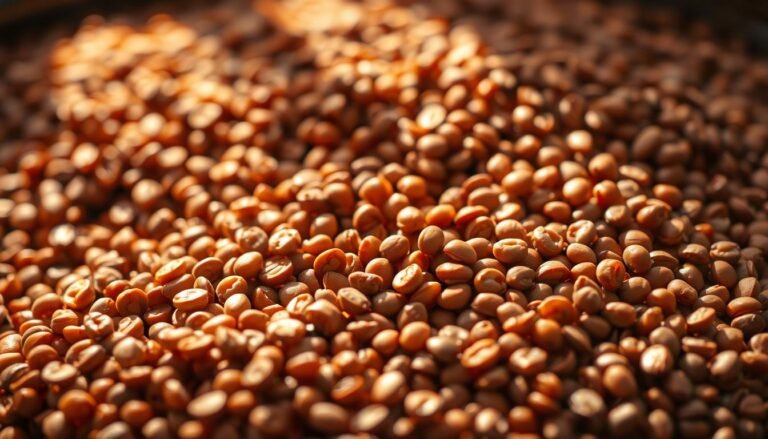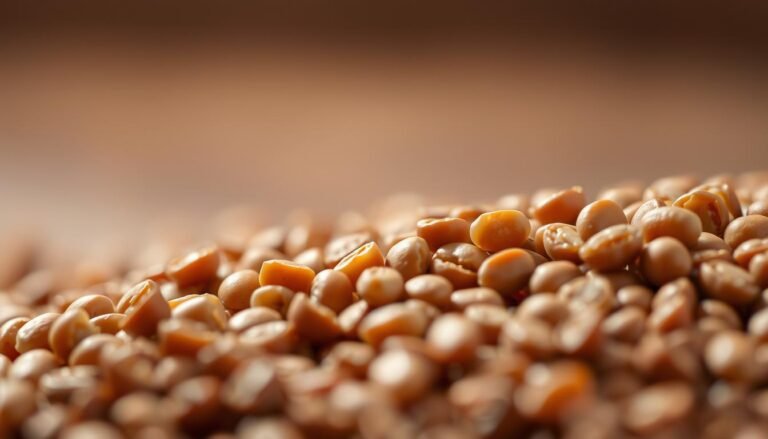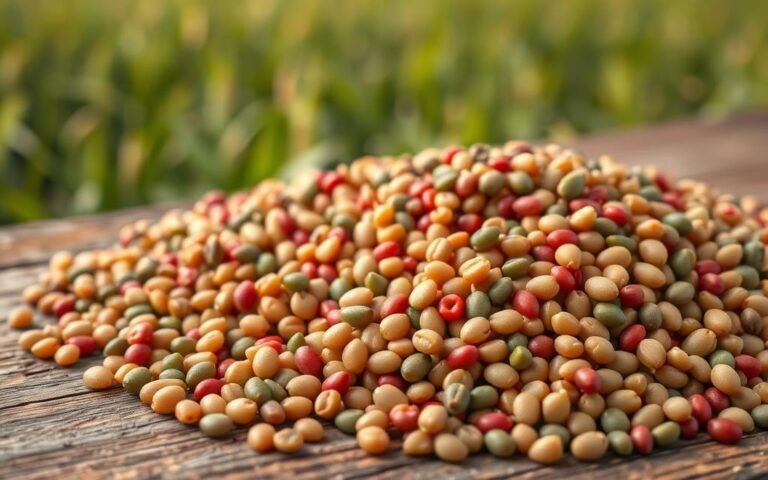Feeling tired and sluggish can be a real drag, especially when it becomes a constant companion. For many Australians, this persistent fatigue can be a sign of underlying iron deficiency, a condition that affects millions worldwide.
A well-balanced diet rich in essential nutrients is crucial for maintaining healthy iron levels. One food that stands out for its impressive nutritional profile is lentils, a staple in many cuisines.
Lentils are an excellent source of iron, with a single cup of cooked lentils providing 6.6 mg of this vital mineral. Incorporating lentils into your diet can be a natural and effective way to combat fatigue and anemia.
Key Takeaways
- Lentils are a rich source of iron, essential for combating fatigue and anemia.
- A diet lacking in iron can lead to persistent tiredness and sluggishness.
- Incorporating iron-rich foods like lentils can help maintain healthy iron levels.
- Lentils are a nutritious addition to a balanced diet, providing a range of essential nutrients.
- Iron deficiency is a common condition affecting millions worldwide.
The Hidden Epidemic of Iron Deficiency in Australia
Iron deficiency is a growing concern in Australia, affecting millions of people nationwide. Despite its prevalence, many are unaware of the risks and consequences of low iron levels. It’s essential to understand the symptoms, risk factors, and the link between iron deficiency, fatigue, and anemia.
Common Symptoms of Low Iron Levels
Low iron levels can manifest in various ways, making it a challenging condition to diagnose. Common symptoms include:
- Persistent fatigue and weakness
- Shortness of breath and dizziness
- Pale skin and brittle nails
- Headaches and poor concentration
These symptoms can significantly impact daily life, making it crucial to identify and address iron deficiency early.
Why Australians Are at Risk for Iron Deficiency
Several factors contribute to the high risk of iron deficiency in Australians. These include:
- A diet lacking in iron-rich foods, particularly plant-based sources
- Increased demand for iron during pregnancy and menstruation
- Certain medical conditions that affect iron absorption
- A growing trend towards vegetarian and vegan diets without proper iron supplementation
Being aware of these risk factors can help individuals take proactive steps to maintain healthy iron levels.
The Connection Between Iron, Fatigue and Anemia
Iron plays a vital role in producing hemoglobin, a protein in red blood cells that carries oxygen throughout the body. Low iron levels can lead to iron deficiency anemia, a condition characterized by extreme fatigue, weakness, and a reduced capacity for physical activity. Understanding this connection is key to addressing the root cause of fatigue and related symptoms.
Lentils: A Nutritional Powerhouse for Aussie Diets
With their rich nutritional content, lentils are increasingly being recognized as a dietary powerhouse in Australia. Lentils are not only rich in iron but also provide other essential nutrients, making them a valuable addition to a healthy diet.
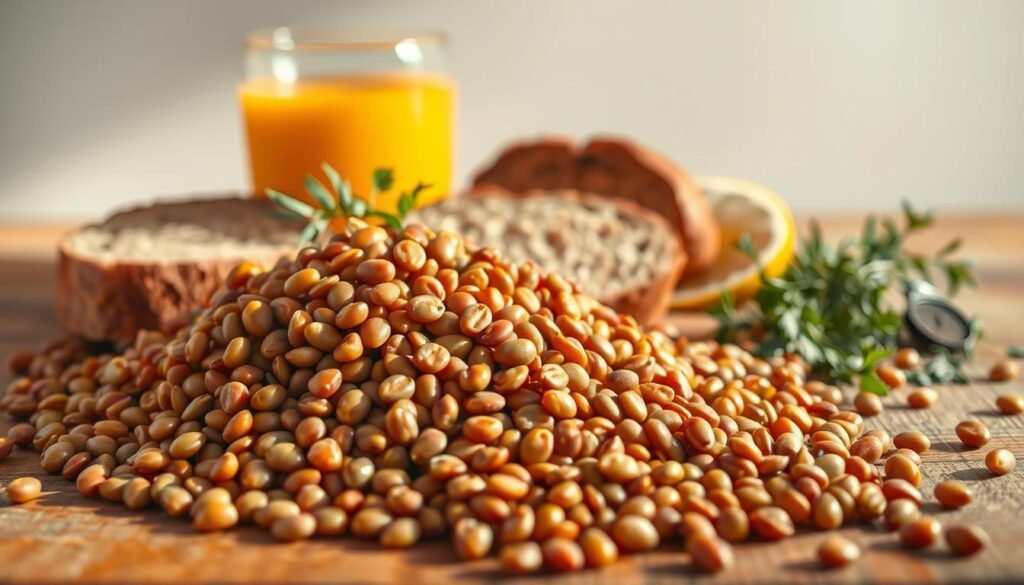
Complete Nutritional Profile of Lentils
Lentils are a nutrient-dense food, providing a rich source of protein, fiber, and various vitamins and minerals. They are particularly high in iron, making them an excellent choice for those looking to boost their iron intake. A single serving of lentils can provide a significant portion of the daily recommended intake of iron, along with other essential nutrients like folate, potassium, and manganese.
Why Lentils Are Gaining Popularity in Australia
Lentils are gaining popularity in Australia due to their versatility in cooking and their nutritional benefits. They can be incorporated into a variety of dishes, from soups and stews to salads and curries. Their ability to absorb flavors and their tender texture when cooked make them a favorite among chefs and home cooks alike.
Sustainability and Affordability of Lentils
Lentils are not only nutritious but also sustainable and affordable. They require less water to cultivate compared to many other protein sources, making them an environmentally friendly choice. Additionally, lentils are generally priced lower than many other legumes and protein sources, making them accessible to a wide range of consumers.
Incorporating lentils into one’s diet can have numerous health benefits, including increased energy levels due to their high iron content. As Australians become more health-conscious and environmentally aware, the popularity of lentils is likely to continue growing.
Iron Content in Lentils: A Comprehensive Analysis
Different types of lentils have distinct iron levels, cooking properties, and nutritional profiles. This diversity makes lentils a versatile and valuable ingredient for addressing iron deficiency and promoting overall health. By understanding the iron content in various lentil types, individuals can make informed choices about their diet.
Red Lentils: Iron Levels and Cooking Properties
Red lentils, such as Uncle Ben’s Red Lentil, contain approximately 6.6mg of iron per cup cooked. They are known for their quick cooking time and soft texture, making them ideal for soups and stews. Red lentils are also rich in fiber, protein, and other essential nutrients.
Green Lentils: Iron Content and Culinary Uses
Green lentils have a slightly different nutritional profile compared to red lentils and retain their shape well after cooking. They are versatile and can be used in salads, side dishes, and main courses. Green lentils are a good source of iron, although the exact content may vary based on the specific variety and cooking method.
Brown Lentils: Iron Content and Nutritional Benefits
Brown lentils are another popular variety, known for their earthy flavor and firm texture. They are rich in iron, fiber, and protein, making them a nutritious addition to a variety of dishes. Brown lentils hold their shape well when cooked, making them suitable for salads and hearty stews.
In conclusion, the iron content in lentils makes them an excellent choice for those looking to increase their iron intake naturally. By incorporating different types of lentils into their diet, individuals can not only combat iron deficiency but also enjoy a range of culinary delights.
Plant-Based Iron Absorption: Challenges and Solutions
For Australians embracing a plant-based diet, comprehending the nuances of iron absorption from sources like lentils is vital. Iron is an essential nutrient, and its deficiency is a significant health concern. Unlike iron from animal sources, plant-based iron has unique absorption challenges.
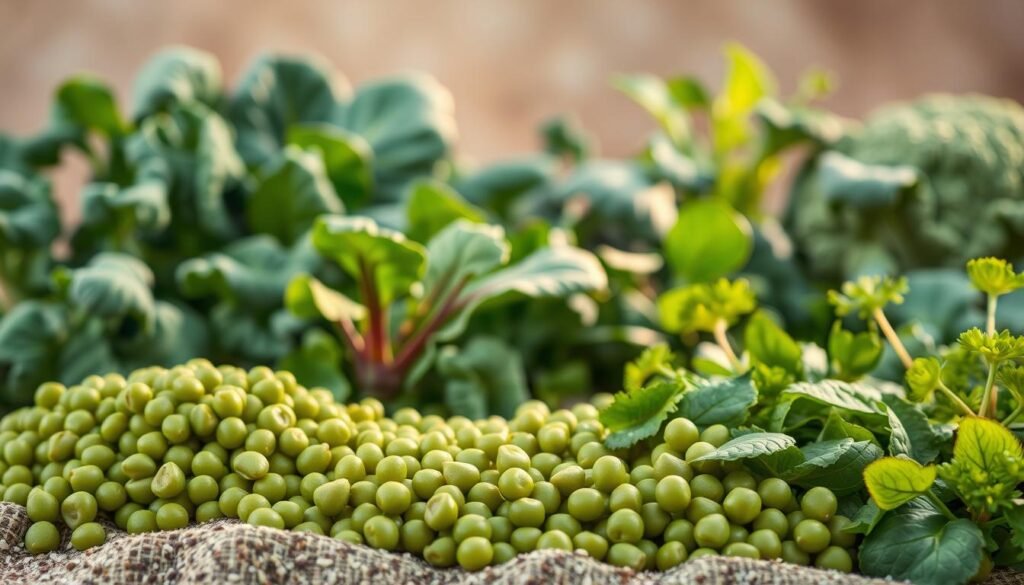
Heme vs. Non-Heme Iron: What’s the Difference?
Iron comes in two forms: heme and non-heme. Heme iron, found in animal products, is more easily absorbed by the body. Non-heme iron, found in plant-based foods like lentils, has a lower absorption rate. However, this doesn’t diminish the importance of lentils as a valuable iron source.
Bioavailability of Iron in Lentils
The bioavailability of iron in lentils is influenced by various factors, including the type of lentil, cooking methods, and the presence of other nutrients. While non-heme iron has a lower absorption rate compared to heme iron, there are ways to enhance its bioavailability.
Nutrients That Enhance Iron Absorption from Lentils
Certain nutrients can significantly improve the absorption of non-heme iron from lentils. Vitamin C is particularly effective; consuming foods high in vitamin C (like citrus fruits or bell peppers) along with lentils can boost iron absorption. Other beneficial nutrients include folate and vitamin A.
To maximize iron intake from lentils, consider the following tips:
- Pair lentils with vitamin C-rich foods.
- Use cooking methods that preserve iron, such as steaming.
- Incorporate a variety of iron-rich plant-based foods into your diet.
By understanding the challenges and implementing these solutions, Australians can effectively utilize lentils as a primary source of iron, contributing to better overall health and reduced risk of iron deficiency.
How Lentils Compare to Other Iron Sources in Australia
For Australians seeking to improve their iron levels, comparing lentils to other iron sources can help make informed dietary choices. Lentils are a nutrient-rich food that provides a significant amount of iron, but how do they stack up against other iron-rich foods?
Lentils vs. Red Meat: Iron Content Comparison
Lentils contain about 6.6 mg of iron per cup cooked. In contrast, red meat contains varying amounts of heme iron, which is more easily absorbed by the body than the non-heme iron found in lentils. However, lentils offer a more sustainable and affordable option without the saturated fats found in red meat.
| Food Item | Iron Content (mg per serving) |
|---|---|
| Lentils (1 cup cooked) | 6.6 |
| Red Meat (100g serving) | Varies (avg. 3-4 mg) |
| Spinach (1 cup cooked) | 4.9 |
Lentils vs. Other Plant-Based Iron Sources
Lentils are not the only plant-based source of iron, but they are one of the richest. Other sources include spinach, beans, and fortified cereals. While these alternatives are valuable, lentils provide a complete nutritional profile that includes protein, fiber, and various vitamins and minerals.
Cost-Benefit Analysis: Lentils as Your Primary Iron Source
Choosing lentils as a primary iron source offers several benefits, including cost-effectiveness and nutritional value. Lentils are generally more affordable than red meat and provide a broader range of nutrients. This makes them an excellent choice for Australians looking to improve their iron levels without breaking the bank.
Fighting Fatigue and Anemia with Lentil-Rich Meals
Incorporating lentil-rich meals into your diet can be a game-changer for combating fatigue and anemia. Lentils are a rich source of iron, an essential mineral for transporting oxygen throughout the body and supporting energy production.
How Iron from Lentils Boosts Energy Levels
The iron in lentils plays a crucial role in reducing fatigue by supporting the production of hemoglobin, a protein in red blood cells that carries oxygen to different parts of the body. With adequate iron levels, individuals can experience a significant improvement in their energy levels, making daily tasks more manageable.
Lentils for Athletes and Active Australians
Athletes and active individuals can particularly benefit from incorporating lentils into their diet. The iron in lentils not only boosts energy but also supports recovery after intense physical activity. By maintaining optimal iron levels, athletes can perform at their best and reduce the risk of iron deficiency anemia.
Success Stories: Australians Who Improved Their Iron Levels with Lentils
Many Australians have turned to lentils as a natural way to improve their iron levels and combat fatigue. For instance, endurance athletes have reported enhanced performance and faster recovery times after adding lentil-rich meals to their diet. These success stories highlight the potential of lentils as a dietary solution for individuals struggling with low iron levels.
By making lentils a staple in their diet, Australians can take a proactive approach to fighting fatigue and anemia, leading to improved overall health and wellbeing.
Optimizing Iron Absorption from Your Lentil Dishes
To maximize the iron benefits from lentils, it’s crucial to understand how to enhance absorption. Iron from plant-based sources like lentils is non-heme iron, which isn’t absorbed as efficiently as the heme iron found in animal products. However, there are several strategies to improve absorption.
The Vitamin C Connection: Foods to Pair with Lentils
Vitamin C can significantly enhance non-heme iron absorption. Consuming foods high in vitamin C (such as citrus fruits, bell peppers, and tomatoes) along with lentils can boost iron absorption. For example, adding a squeeze of fresh lemon juice to your lentil soup can make a big difference.
Soaking, Sprouting and Fermenting Techniques
Soaking, sprouting, and fermenting lentils can reduce phytic acid, a compound that inhibits iron absorption. Soaking lentils overnight before cooking can help. Sprouting lentils can further reduce phytic acid and enhance nutrient availability. Fermenting lentils, as in making lentil dosas, can also improve iron absorption.
Cooking Methods That Preserve Iron Content
Cooking lentils in a cast-iron pot can increase iron intake, especially if the lentils are cooked with acidic foods like tomatoes. Avoid overcooking lentils, as this can reduce their iron content. Using gentle heat and minimal water can help preserve the iron in lentils.
Foods and Drinks That Inhibit Iron Absorption
Some foods and drinks can inhibit iron absorption. These include:
- Coffee and tea, due to their polyphenol content
- Calcium-rich foods, as calcium can interfere with non-heme iron absorption
- Foods high in phytates, like whole grains and legumes (though soaking, sprouting, and fermenting can mitigate this)
It’s not necessary to avoid these foods entirely, but being mindful of when you consume them in relation to your lentil meals can help. For instance, having a cup of tea between meals rather than with lentils can minimize its impact on iron absorption.
Australian-Inspired Iron-Rich Lentil Recipes
Australia’s diverse culinary landscape offers a unique opportunity to create iron-rich lentil recipes that not only tantalize the taste buds but also combat fatigue and anemia. The country’s multicultural identity and love for bold flavors make it an ideal place to innovate with lentil-based dishes.
Bush Tucker-Inspired Lentil and Native Spice Soup
This hearty soup combines the nutritional benefits of lentils with the unique flavors of Australia’s native spices, such as lemon myrtle and kakadu plum. Rich in iron and antioxidants, this soup is a perfect example of how lentils can be used to create delicious and healthy meals. The native spices not only add flavor but also provide additional health benefits, making this dish a great way to boost your iron intake.
Mediterranean-Australian Lentil Salad with Citrus
This refreshing salad brings together the iron-rich goodness of lentils with the vibrant flavors of citrus fruits, commonly found in Australian cuisine. By combining cooked lentils with freshly squeezed orange juice, chopped fresh parsley, and a hint of olive oil, this salad is not only rich in iron but also in vitamin C, which enhances iron absorption. It’s a perfect meal for a quick and nutritious lunch.
Lentil and Kangaroo Stew for Maximum Iron Intake
For a more substantial meal, a lentil and kangaroo stew is an excellent option, providing a boost of iron from both the lentils and the kangaroo meat. This stew is not only rich in iron but also in protein, making it a great option for athletes or individuals looking to increase their energy levels. The combination of red lentils, kangaroo meat, and vegetables creates a flavorful and nutritious dish that’s perfect for a cold winter’s night.
Quick Lentil Breakfast Ideas for Busy Aussies
For those in a hurry, lentil-based breakfasts can be a great way to start the day with a boost of iron. Simple recipes like lentil and vegetable omelets or lentil and avocado toast on whole-grain bread can be prepared quickly. These meals are not only rich in iron but also provide sustained energy throughout the morning, making them ideal for busy Australians.
Special Considerations for Lentil Consumption
For most Australians, incorporating lentils into their diet can be highly beneficial, yet there are exceptions to consider. Lentils are rich in plant-based iron sources, making them an excellent choice for those looking to boost their iron intake.
Who Should Monitor Their Lentil and Iron Intake
Certain individuals should be cautious with their lentil consumption. For instance, people with hemochromatosis, a condition characterized by excessive iron absorption, should monitor their iron intake closely. According to research published on PMC, managing iron intake is crucial for individuals with this condition.
Additionally, those on medications that affect iron absorption or have conditions like celiac disease that impair nutrient absorption should also be mindful of their lentil and overall iron intake.
Balancing Lentils in Your Weekly Meal Plan
To balance lentils effectively in your diet, consider the following table, which outlines a sample weekly meal plan incorporating lentils:
| Day | Meal | Lentil Serving |
|---|---|---|
| Monday | Lentil Soup | 1 cup cooked |
| Wednesday | Lentil Salad | 1/2 cup cooked |
| Friday | Lentil Curry | 3/4 cup cooked |
As illustrated, varying your lentil intake across different meals can help maintain a balanced diet. It’s also beneficial to pair lentils with foods high in Vitamin C to enhance iron absorption, as noted in previous sections.
“A well-planned diet that includes lentils can significantly improve iron levels, especially for those transitioning to plant-based iron sources.”
By being mindful of these considerations, Australians can enjoy the nutritional benefits of lentils while maintaining a balanced and healthy diet.
Conclusion: Embracing Lentils as Your Natural Iron Supplement
Lentils are a natural and effective way to boost iron intake and combat fatigue and anemia. With their high iron content, lentils can be a valuable addition to your diet, providing a much-needed energy boost.
Incorporating lentils into your meals can have a significant impact on your overall health, particularly for Australians who are at risk of iron deficiency. By choosing lentils as a primary iron source, you can enjoy a range of benefits, from improved energy levels to enhanced overall well-being.
To maximize the iron content in lentils, it’s essential to pair them with vitamin C-rich foods and adopt cooking methods that preserve iron. With their versatility and nutritional profile, lentils are an excellent choice for those seeking a natural iron supplement. By embracing lentils as a staple in your diet, you can take a proactive approach to maintaining healthy iron levels and enjoying optimal energy.

